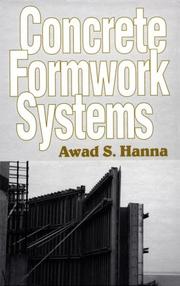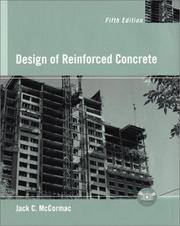| Listing 1 - 10 of 170 | << page >> |
Sort by
|
Book
Year: 2020 Publisher: London : IntechOpen,
Abstract | Keywords | Export | Availability | Bookmark
 Loading...
Loading...Choose an application
- Reference Manager
- EndNote
- RefWorks (Direct export to RefWorks)
Concrete made using mineral cements, the raw materials which on earth are practically endless, is known as one of the oldest building materials and during the last decades of the twentieth century has become a dominant building material for general use. At the same time, the requirements of the quality of concrete and its performance properties, in particular compressive strength, durability, economical efficiency, and low negative impact of its manufacture on the environment have not yet been completely met. Bearing these requirements in mind, researchers and engineers worldwide are working on how to satisfy these requirements. This book has been written by researchers and experts in the field and provides the state of the art on recent progress achieved on the properties of concrete, including concrete in which industrial by-products are utilized. The book is dedicated to graduate students, researchers, and practicing engineers in related fields.
Book
ISBN: 3035612528 303561167X 9783035611670 9783035612523 Year: 2015 Publisher: Basel/Berlin/Boston
Abstract | Keywords | Export | Availability | Bookmark
 Loading...
Loading...Choose an application
- Reference Manager
- EndNote
- RefWorks (Direct export to RefWorks)
Grundlagen der Betonkonstruktion
Book
ISBN: 1443855251 9781443855259 1306309271 9781306309271 1443852368 9781443852364 Year: 2013 Publisher: Newcastle upon Tyne Cambridge Scholars Publishing
Abstract | Keywords | Export | Availability | Bookmark
 Loading...
Loading...Choose an application
- Reference Manager
- EndNote
- RefWorks (Direct export to RefWorks)
In this book, three potential solutions to the issue of steel congestion in reinforced concrete (RC) structures are researched. The first method examines RC mixed with steel fibers. The use of steel fibers instead of stirrups results in the reduction of reinforcing congestion in a manner which is both effective in reducing the effects of congestion and practical to implement. In the second method, reinforcing congestion in RC or prestressed concrete (PC) structures is effectively reduced by t...

ISBN: 0429222009 1135550433 1280096721 0203909690 9786610096725 082474635X 0585134596 9780585134598 9780203909690 6610096724 9781135550431 9781135550387 1135550387 9781135550424 1135550425 0824700724 9780824700720 Year: 1999 Publisher: New York Marcel Dekker
Abstract | Keywords | Export | Availability | Bookmark
 Loading...
Loading...Choose an application
- Reference Manager
- EndNote
- RefWorks (Direct export to RefWorks)
Offers insights on currently-used concrete formwork structures, from classification, system components and materials' properties to selection and construction requirements and procedures, while considering product quality, labour, safety and economic factors throughout.
Concrete construction --- Forms (Concrete construction) --- Carpentry --- Formwork.
Book
ISBN: 0429178522 1482266792 9781482266795 9780203817155 020381715X 9780415663489 0415663482 Year: 2014 Publisher: Boca Raton, FL : CRC Press,
Abstract | Keywords | Export | Availability | Bookmark
 Loading...
Loading...Choose an application
- Reference Manager
- EndNote
- RefWorks (Direct export to RefWorks)
"Detailing is an essential part of the design process. This thorough reference guide for the design of reinforced concrete structures is largely based on Eurocode 2 (EC2), plus other European design standards such as Eurocode 8 (EC8), where appropriate.With its large format, double-page spread layout, this book systematically details 213 structural elements. These have been carefully selected by José Calavera to cover relevant elements used in practice. Each element is presented with a whole-page annotated model along with commentary and recommendations for the element concerned, as well as a summary of the appropriate Eurocode legislation with reference to further standards and literature. The book also comes with a CD-ROM containing AutoCAD files of all of the models, which can be directly developed and adapted for specific designs.Its accessible and practical format makes the book an ideal handbook for professional engineers working with reinforced concrete, as well as for students who are training to become designers of concrete structures."--Provided by publisher.
Reinforced concrete construction --- Concrete construction --- Details. --- Standards
Book
ISBN: 3030801381 303080139X Year: 2022 Publisher: Cham, Switzerland : Springer,
Abstract | Keywords | Export | Availability | Bookmark
 Loading...
Loading...Choose an application
- Reference Manager
- EndNote
- RefWorks (Direct export to RefWorks)
Reinforced concrete construction --- Standards --- Concrete construction
Book
ISBN: 3035731055 9783035731057 3035711054 9783035711059 Year: 2017 Publisher: Zurich Trans Tech Publicaitons
Abstract | Keywords | Export | Availability | Bookmark
 Loading...
Loading...Choose an application
- Reference Manager
- EndNote
- RefWorks (Direct export to RefWorks)
This book was collected by results of the 23rd International Conference Concrete Days 2016 (Litomyšl, Czech Republic from November 30 to December 1, 2016).The papers introduce recent research results in area of modern concretes and concrete structures, discussed issues of modelling and design of concrete structures, bridges and buildings, properties of concretes and also the significant structural projects and them realizations. Concrete, structural elements and systems, mechanical properties, bridges, modeling, design, modern technologies, materials science.
Book
Year: 2023 Publisher: Basel : MDPI - Multidisciplinary Digital Publishing Institute,
Abstract | Keywords | Export | Availability | Bookmark
 Loading...
Loading...Choose an application
- Reference Manager
- EndNote
- RefWorks (Direct export to RefWorks)
Streams and rivers are subject to considerable hydrodynamic loads. Flow interactions with natural or man-made structures in open channels lead to the development of complex dynamic processes, requiring further studies to comprehend fully. This Special Issue has been conceived to facilitate improvement or propose new approaches, summarize the most important findings of previous studies, and encourage the development of further knowledge in the field of open-channel flows. Various topics are addressed in this SI, including flow interaction with hydraulic structures, flow dynamics in estuaries, flow-vegetation interactions, bed sediment effects on flow structures, and the effect of channel curvature on flow behaviors and sediment transport. The studies published in this Special Issue certainly help readers understand the turbulent flow involved in open channels and apply that understanding to the design and practice of hydraulic engineering and river management.

ISBN: 0471395765 Year: 2001 Publisher: S.l. Wiley & Sons
Abstract | Keywords | Export | Availability | Bookmark
 Loading...
Loading...Choose an application
- Reference Manager
- EndNote
- RefWorks (Direct export to RefWorks)
Periodical
Abstract | Keywords | Export | Availability | Bookmark
 Loading...
Loading...Choose an application
- Reference Manager
- EndNote
- RefWorks (Direct export to RefWorks)
| Listing 1 - 10 of 170 | << page >> |
Sort by
|

 Search
Search Feedback
Feedback About UniCat
About UniCat  Help
Help News
News